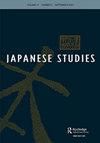Crisis and Literature in Contemporary Japan: From 3-11 to the COVID-19 Pandemic in Kanehara Hitomi’s Fiction
IF 0.4
Q3 AREA STUDIES
引用次数: 0
Abstract
ABSTRACT It has been observed that ‘3–11’ marked an inflection point in Japanese cultural discourse, after which there prevailed a broad malaise about the social faults and systemic inequities that the natural and nuclear disasters had exposed in their aftermath. Kanehara Hitomi’s novel Motazaru Mono (Those without, 2015) explores this affective shift through her characters’ struggles to contend with the upending of their worldviews and values since 2011. In turn, Kanehara’s stories written during the COVID-19 pandemic’s peak of 2020–2021 show characters responding to the global crisis through the lens of a generalized state of precarity that, I argue, harkens back to 3–11 and earlier. With reference to Lauren Berlant’s notion of the ‘crisis ordinary’ mentality, I analyze ‘Unsocial Distance’ (June 2020), a love story between two youths who regard COVID-19 as an inconvenience rather than a true emergency. I then examine ‘Techno-break’ (January 2021) which ends with the protagonist’s mental and moral devolution in the socially distanced solitude she first enters as an anti-COVID measure. ‘Techno-break’ advocates for confronting the tolls of the prolonged pandemic, and for addressing the deeper-seeded fault-lines of Japanese society that contribute to more recent challenges.当代日本的危机与文学:从3-11到金原仁小说中的新冠肺炎大流行
据观察,“3-11”标志着日本文化话语的一个拐点,在此之后,自然灾害和核灾难在其后果中暴露出的社会缺陷和系统性不平等普遍存在。金原瞳的小说《没有的人》(Motazaru Mono, 2015)探讨了这种情感转变,通过她的人物在2011年以来与世界观和价值观的颠覆作斗争。金原原在2020-2021年COVID-19大流行高峰期写的故事,通过一种普遍的不稳定状态的镜头,展示了人物对全球危机的反应,我认为,这种不稳定状态可以追溯到3-11及更早的时候。参考劳伦·伯兰特(Lauren Berlant)的“危机普通”心态概念,我分析了《非社会距离》(Unsocial Distance)(2020年6月),这是两个年轻人之间的爱情故事,他们认为COVID-19是一种不便,而不是真正的紧急情况。然后,我研究了2021年1月的《科技休息》(Techno-break),它以主人公在社交疏远的孤独中精神和道德的堕落结束,她最初是为了对抗新冠病毒而进入的。“科技突破”主张直面长期大流行带来的损失,并解决日本社会根深蒂固的断层线,这些断层线导致了最近的挑战。
本文章由计算机程序翻译,如有差异,请以英文原文为准。
求助全文
约1分钟内获得全文
求助全文

 求助内容:
求助内容: 应助结果提醒方式:
应助结果提醒方式:


